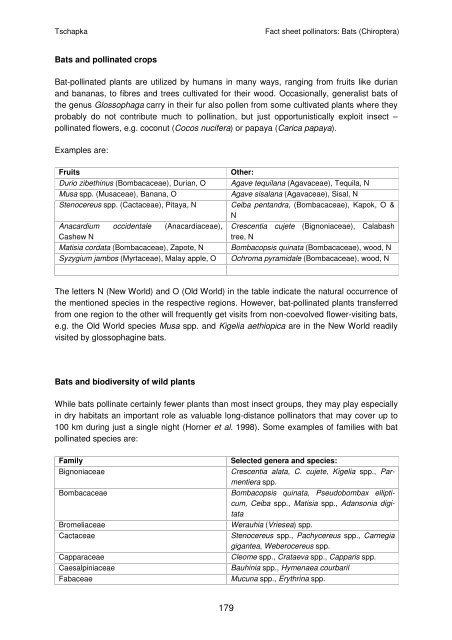Caring for Pollinators - Bundesamt für Naturschutz
Caring for Pollinators - Bundesamt für Naturschutz
Caring for Pollinators - Bundesamt für Naturschutz
You also want an ePaper? Increase the reach of your titles
YUMPU automatically turns print PDFs into web optimized ePapers that Google loves.
Tschapka Fact sheet pollinators: Bats (Chiroptera)<br />
Bats and pollinated crops<br />
Bat-pollinated plants are utilized by humans in many ways, ranging from fruits like durian<br />
and bananas, to fibres and trees cultivated <strong>for</strong> their wood. Occasionally, generalist bats of<br />
the genus Glossophaga carry in their fur also pollen from some cultivated plants where they<br />
probably do not contribute much to pollination, but just opportunistically exploit insect –<br />
pollinated flowers, e.g. coconut (Cocos nucifera) or papaya (Carica papaya).<br />
Examples are:<br />
Fruits Other:<br />
Durio zibethinus (Bombacaceae), Durian, O Agave tequilana (Agavaceae), Tequila, N<br />
Musa spp. (Musaceae), Banana, O Agave sisalana (Agavaceae), Sisal, N<br />
Stenocereus spp. (Cactaceae), Pitaya, N Ceiba pentandra, (Bombacaceae), Kapok, O &<br />
N<br />
Anacardium occidentale (Anacardiaceae),<br />
Cashew N<br />
179<br />
Crescentia cujete (Bignoniaceae), Calabash<br />
tree, N<br />
Matisia cordata (Bombacaceae), Zapote, N Bombacopsis quinata (Bombacaceae), wood, N<br />
Syzygium jambos (Myrtaceae), Malay apple, O Ochroma pyramidale (Bombacaceae), wood, N<br />
The letters N (New World) and O (Old World) in the table indicate the natural occurrence of<br />
the mentioned species in the respective regions. However, bat-pollinated plants transferred<br />
from one region to the other will frequently get visits from non-coevolved flower-visiting bats,<br />
e.g. the Old World species Musa spp. and Kigelia aethiopica are in the New World readily<br />
visited by glossophagine bats.<br />
Bats and biodiversity of wild plants<br />
While bats pollinate certainly fewer plants than most insect groups, they may play especially<br />
in dry habitats an important role as valuable long-distance pollinators that may cover up to<br />
100 km during just a single night (Horner et al. 1998). Some examples of families with bat<br />
pollinated species are:<br />
Family Selected genera and species:<br />
Bignoniaceae Crescentia alata, C. cujete, Kigelia spp., Parmentiera<br />
spp.<br />
Bombacaceae Bombacopsis quinata, Pseudobombax ellipticum,<br />
Ceiba spp., Matisia spp., Adansonia digitata<br />
Bromeliaceae Werauhia (Vriesea) spp.<br />
Cactaceae Stenocereus spp., Pachycereus spp., Carnegia<br />
gigantea, Weberocereus spp.<br />
Capparaceae Cleome spp., Crataeva spp., Capparis spp.<br />
Caesalpiniaceae Bauhinia spp., Hymenaea courbaril<br />
Fabaceae Mucuna spp., Erythrina spp.

















